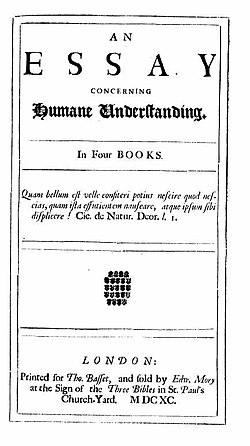Title recording
Title inclusion (or cataloging ) is a term used in library and book studies that records how titles are included in library catalogs and bibliographies .
There are no uniform rules here, as the requirements for recordings are extremely different. On the one hand, uniformity and standardization are to be aimed for, they enable the quick comparison of entries and the merging of information in databases; On the other hand, the aim is to map peculiarities in individual areas: Codices from the Middle Ages and prints from the early modern period are attempted in bibliographies with the peculiarities of editions so that one can even identify variants of a single edition.
Title recording, cataloging, title and catalog
The result of the entry of a title is the catalog , which means the data record that is created when a title has been included in a catalog. A catalog does not only describe book titles . Since other media or data carriers are also included in today's libraries , e.g. A catalog can also represent this type of title, for example music CDs and films on DVDs or reference works on data carriers. The sum of the cataloged items forms the basis of the catalog. “Title recording” refers to both the rule according to which the catalog is to be created and the process of creation. If you create a title recording, you write an instructive text or create an algorithm ; if you record a title, you create a catalog.
Instructions for the detailed recording of printed titles from the early modern period
The optimum is a reproduction of the title page , it is often included in various bibliographies and catalogs in small images. Annotated standard bibliographies such as Gerhard Dünnhaupt's Personalbibliographien zu den Druck des Barock , Vol. 1–6 (Stuttgart, 1990–93) offer different, but ultimately similar, alternatives for transcribing the title page. The illustration opposite can be transcribed in relatively detail using this pattern. The aim of the transcription is to make visible which information the title page offered in which emphasis (therefore the note of the line break) and which it did not (here, for example, the author is missing, it will only be found on the title page in the following editions ):
- AN | ESSAY | CONCERNING | [Fraktur:] HUMANE UNDERSTANDING | [Line] | In Four BOOKS | [Line] | Quam bellum est velle confiteri potius nescire quod nes- | cias, quam ista effutientem nauseare, atque ipsum sibi | displicere! Cic. De nature. Deor. I. 1. | [Double line] | [Ornament] | [Double line] | LONDON | Printed for Tho. Basset, and sold by Edw. Mory, | at the Sign of the Three Bibles in St. Paul ' s | Church yard. MDCXC.
The complete title includes statements on the frontispiece and copper - information that is omitted in this example. When recording the title in more detail, it is important to note the parts into which the book is divided. In most cases, the edition available to the bibliographer is described (with “location information”, i.e. information on the library and the shelf number). If other editions bind the individual parts together differently, this will be noted down to the knowledge of the bibliographer. The bibliographer can just as easily note the correct binding and note how the copy available to him deviated from it (there are sometimes considerable differences here, for example if the binder has assumed that tables of contents are either before or after the text block). When counting pages, you can count unpaginated sheets (each sheet has a front and a back) or you can introduce your own Latin pagination, as in the following title recording. The count begins with the title page , the square brackets note whether the information is given in the book or introduced by the bibliographer. The title recording notes the individual parts of the book such as dedication , reader's preface , text, table of contents , register , and it notes down details: signatures and dates are important here - the following shows that the title was by no means anonymous, the author gave in this case but not to where and when he parted with his manuscript. The last note applies here to the format - 4 ° quart :
- p. [i] Title page / p. [iii-vi] Dedication: Thomas Earl of Pembroke and Montgomery, signed: John Locke / p. [vii-xi] "Epistle to the Reader" / p. [xii] "Errata" / p.1-362 text divided into "4 books" / p. [363-64] content rough overview / p. [365-84] detailed table of contents with sequence of the individual thoughts / 4 °. [Quoted from the Henry E. Huntington Library and Art Gallery edition]
Should the bibliographer intervene in the text and provide additional information or corrections, for example in the case of pseudonyms , he should make this visible by using square brackets so that it can be seen which information the book actually provided the reader in which way.
Library rules
The following individual pages provide more detailed information on the most important regulations in library science and on how publications are included in index cards or data records :
- Rules for Alphabetical Cataloging (RAK)
- Prussian Instructions (PI)
- Berlin Instructions (BA)
- Anglo-American Cataloging Rules (AACR)
- Recommendations of the Arbeitsgemeinschaft Alte Drucke at the GBV for the development of old prints up to 1850 and others
